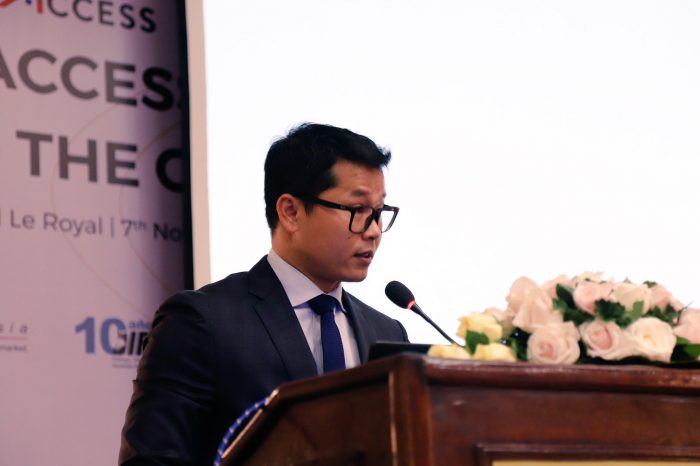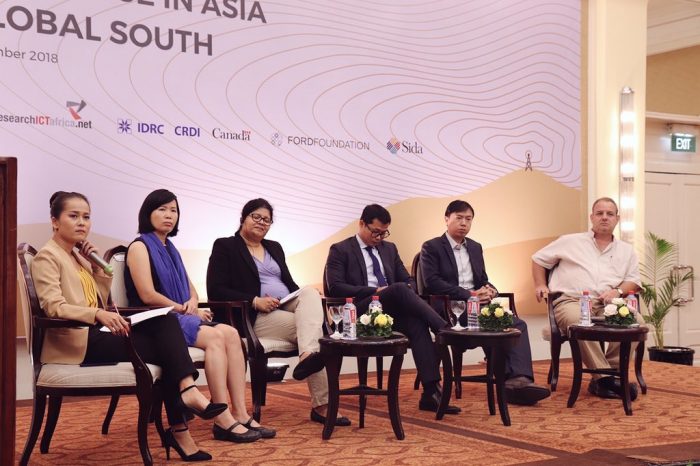Twenty-six percent of all Cambodian Internet users between ages 15 and 65 experienced some form of online harassment, according to the recently-released AfterAccess survey report.
Reports of online harassment were higher among women (29% of women aged 15-65 who use the Internet, vs. 23% of men), with most of the harassment being experienced while using social media platforms, the report showed. Cyberstalking was a concern among female social media users in Cambodia.

“Cambodia does better than Pakistan and India, both wealthier countries, in terms of mobile phone ownership,” said Helani Galpaya, lead researcher for the Asia components of the surveys and CEO of LIRNEasia, a regional ICT policy think-tank. “But considering all the attention that the telecom industry has received in the recent past, and the proactive measures being taken with regard to policy action in the field, the harassment number seems to be a reason for concern.”
The report also stated that only 11% of the 15-65 population responded “yes” when asked if they knew what the Internet was (without any explanation of what it is). Interestingly, 36% of the same population claimed that they used the Internet, when probed about use of Facebook, Gmail, WhatsApp and other Internet-enabled services.
“This is a phenomenon we first identified in Indonesia in 2012, when respondents told us that they used Facebook but not the Internet,” stated Senior Research Manager at LIRNEasia, Ayesha Zainudeen. “The AfterAccess surveys were conducted more recently, in September-October 2017. The higher use of Internet against awareness shows that even today, a large proportion of the 15-65 population in Cambodia lack understanding on what the Internet is.”
Related to lack of awareness is the fact that the key reason respondents gave for not using the Internet is not knowing how.
“The indicators are clear that in order to get more Cambodian people online, we need to create awareness on what the Internet is, and how to use it,” said Zainudeen.
But the picture is not completely bleary. Eighty-five percent of Cambodian mobile phone owners aged 15-65 used some kind of app on their mobile phone. This was the highest app use among all Asian and African countries surveyed. In addition, 52% of social media users indicated that they “always” verify the truthfulness of content on social media before sharing it.
The findings are part of AfterAccess, an international-award-winning effort to collect robust data on access to and use of mobile phones, Internet, social media and online platforms in the Global South.
“The available information on mobile phones and the Internet is supply-side provided or not representative of national populations. That makes it insufficient for governments and other decision makers,” continued Galpaya. “The only meaningful way to understand the ground situation is by talking to users (and non-users) directly. This is what we have done with the AfterAccess surveys.”
The Cambodia-specific results of the AfterAccess surveys were released by regional ICT-policy think-tank, LIRNEasia, in Phnom Penh on November 7th, 2018. Speakers at the event included H. E. Dr. Kan Chanmetta – Secretary of State for Posts and Telecommunications, Jonathan Yap – Head of Regulatory & Corporate Affairs at Smart Axiata, Javier Sola – Chief of Party of the USAID funded SPICE program in Cambodia and Channe Suy Lan – Regional Lead at InSTEDD Innovation Lab of South Asia (iLab SEA).

The AfterAccess report highlights key areas for development in ICT sectors of Cambodia, India, Pakistan, Bangladesh, Myanmar and Nepal. These include urban and rural as well as gender patterns in mobile phone ownership and Internet use, ecommerce, social media and online harassment.
“This data is highly relevant not only for policy-makers but also to the industry. It is already being used to inform ICT policy in India and we trust that Cambodian stakeholders will recognize its importance as well,” Galpaya stated.
In Cambodia, 2,100 households and individuals were surveyed from 100 villages in 25 provinces. The sampling methodology was designed to ensure representation of the target group (population aged 15-65) at a national level with 95% confidence interval and a +/-3.3% margin of error.
The methodology used in Cambodia is comparable across all 18+ survey countries in Africa, Asia and Latin America. The AfterAccess database is thus the most rigorous and comprehensive database on mobile phone and Internet access and use in the Global South. The current data includes information collected via 38,005 face-to-face interviews of households and individuals. The data allows for disaggregation by gender, rural or urban setting and age among other factors.
This research was conducted with financial support from the International Development Research Centre (IDRC), Canada, the UK Government’s Department for International Development (DFID), the Ford Foundation and the Swedish International Development Cooperation Agency (SIDA).
ENDS
Other key findings from the Cambodia report:
- Mobile ownership was at 68% of the 15-65 population in Cambodia, still doing better than India and Pakistan (both who have higher incomes), however connectivity is not even. There was an urban-rural gap of 21%, i.e., rural dwellers were 21% less likely to own a mobile than urban ones. Similarly, the gender gap was at 20%, so females are 20% less likely to own a mobile than males, within the 15-65 age groups.
- Twenty nine percent of mobile owners aged 15-65 had more than one SIM card.
- Just 11% of the 15-65 population were aware of the Internet (they were asked if they know what the ‘Internet’ is, without explanation of what it is), while 36% claimed to use it (when probed using examples such as Facebook, Google, Gmail, YouTube etc.), indicating a lack of understanding of what the Internet is, even though they use it through apps and other data services.
- Eighty-five percent of mobile owners aged 15-65 with an Internet-enabled phone (i.e., feature or smartphone indicated that they used some kind of app on their mobile – this was the highest use in the Asian (and African) survey countries.
- 30% of the 15-65 population indicated that they were using social media.
- 48% of mobile owners had a smartphone; while 42% had basic phones (with no Internet capability); the remainder used feature phones, which had some basic level of Internet capability.
- Affordability was the key reason cited by basic or feature phone owners for not owning a smartphone.
- There were considerable gaps in Internet use between urban and rural populations (40% gap) as well as the genders (34% gap).
- 43% of Internet users came online within the last 12 months.
- The key limitation on Internet use among current users was the speed of the Internet – 70% said this was a limiting factor.
- Among non-users, the key reason cited was a lack of skills (not knowing how to use it) as well as not having a device to use it on.
- More than one third of mobile owners with either a smart or feature phone said they have news apps installed on their phone and 86% of social media users said they use it for reading news. More than 40% of social media users said they trust the news read on social media, the second-highest level of trust seen in the survey countries. Fifty-two percent of social media users indicated that they ‘always’ verify the truthfulness of content on social media before sharing it. Very few shared without checking first.
- Among the survey countries, Cambodia saw the highest level of reported online harassment, with 26% of internet users reporting having experienced some form of online harassment. Reports were particularly higher among women, with most of the harassment being experienced while using social media platforms. Cyberstalking was particularly a concern among female social media users in Cambodia.
- There was some awareness of platforms for buying and selling goods and services among Internet users, particularly 42% of 15-65 Internet users were aware of being able to hire help through platforms, 32% were aware of ecommerce possibilities and 34% were aware of possibilities of online freelancing/microwork through the Internet. However in Cambodia, awareness had not yet been translated into use. Barriers cited were that of skills (not knowing how exactly to do it), relevance (not needing to do so) as well as some lesser concerns of quality and trust.
Link to the report: https://lirneasia.net/2018/10/afteraccess-asia-report2/?fbclid=IwAR01Kz0U9cRxREdwsbVx_E0ABl4649_kcEXqFuMJ2VKYUYkBFtDjrXba8gw
Link to the presentation: https://lirneasia.net/2018/11/afteraccess-ict-access-and-use-in-cambodia-and-the-global-south-presentation/
